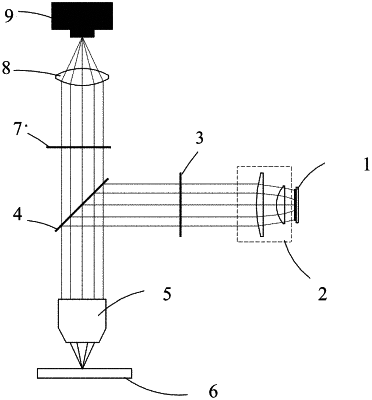| CPC G02B 21/06 (2013.01) [G02B 21/006 (2013.01); G02B 5/08 (2013.01); G02B 27/09 (2013.01)] | 11 Claims |

|
1. A structured illumination microscopic imaging system, comprising:
a structured illumination source;
a beam shaping lens, an excitation optical filter and a dichroic mirror, sequentially provided on an emission light path of the structured illumination source; wherein, the beam shaping lens comprises more than one lens;
an objective lens and a sample, sequentially provided on a first optical path of the dichroic mirror; and
an emission optical filter, a tube lens, and a detector, sequentially provided on a second optical path of the dichroic mirror;
wherein the structured illumination source comprises a micro-sized illuminating light source configured to produce structured light having bright and dark fringes;
wherein the micro-sized illuminating light source comprises a substrate and an array of light emitting units arranged on the substrate; wherein a size of each light emitting unit has a square area in a range of 1 μm×1 μm to 100 μm×100 μm;
wherein each of the light emitting units in the array of light emitting units is independently controllable for obtaining structural light fringes;
wherein a duty ratio is a ratio of the bright and dark fringes, and the duty ratio is one of 1:1, 1:2, or 1:3; and
wherein a spacing between two adjacent light emitting units is determined by a shape of the light emitting unit, a number of lenses included in the beam shaping lens, a focal length of the beam shaping lens, a magnification of the objective lens, and a focal length of the objective lens, causing a spacing between adjacent images on a surface of the sample is less than half of a wavelength of light emitted from the light emitting units.
|